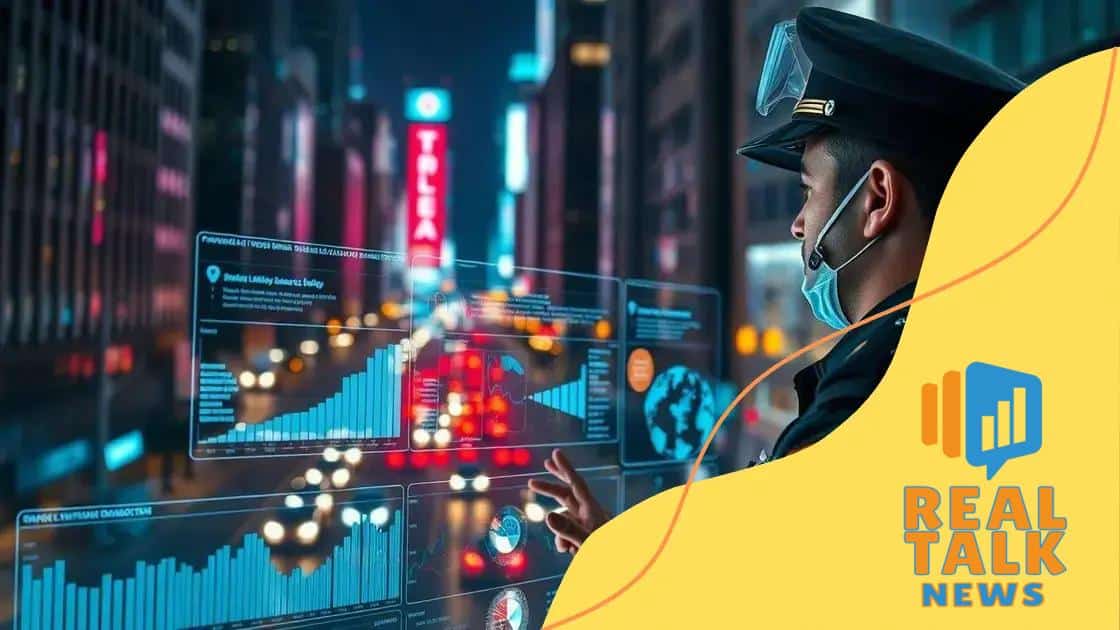The role of AI in improving public safety systems

The role of AI in improving public safety systems involves enhancing emergency responses, preventing crime through predictive analytics, and addressing ethical concerns like bias and privacy to ensure community trust.
The role of AI in improving public safety systems is a topic that resonates deeply as we navigate a rapidly changing world. How can these advanced technologies help protect our communities? In this article, we will explore various ways AI is transforming public safety and the implications of these changes.
Understanding AI’s impact on public safety
Understanding AI’s impact on public safety is crucial as technology continues to evolve. The integration of artificial intelligence in public safety systems is transforming how we respond to emergencies and enhance community security.
Key Advantages of AI in Public Safety
Artificial intelligence provides various advantages that strengthen public safety initiatives. These include:
- Faster response times: AI helps streamline communication between emergency services, allowing for quicker deployment.
- Data analysis: Powerful algorithms analyze crime patterns, helping law enforcement anticipate incidents more effectively.
- Enhanced surveillance: AI technology can process data from surveillance cameras, identifying potential threats in real time.
Moreover, AI systems can use historical data to identify trends and predict where future incidents may occur. This predictive capability is vital in resource allocation and ensuring that police departments are prepared.
Another way AI enhances public safety is through its role in smart city initiatives. These projects leverage AI to improve infrastructure, optimize traffic management, and enhance emergency response plans. Cities utilizing AI systems can monitor real-time data, allowing them to make decisions that better protect citizens and improve overall efficiency.
Challenges of Implementing AI in Public Safety
Despite the many benefits, the adoption of AI in public safety is not without challenges. Privacy concerns often arise as AI systems collect vast amounts of data to function effectively. Striking the right balance between safety and privacy is essential.
Additionally, the potential for bias in AI algorithms can lead to disproportionate policing in certain communities. Recognizing these issues and working towards fair AI systems is crucial for maintaining public trust.
Ultimately, as we further explore AI’s impact on public safety, understanding both the benefits and challenges will allow us to implement these technologies responsibly. Enhanced public safety is an admirable goal, but it requires careful consideration of ethical implications and community needs.
Key technologies enhancing emergency response
Key technologies enhancing emergency response are fundamentally changing how we react to crises. From natural disasters to urban emergencies, advancements in technology are making response efforts more efficient and effective.
AI-Powered Dispatch Systems
AI can significantly improve emergency dispatch systems. By analyzing data in real time, these systems can assess situations rapidly and allocate resources where they are needed the most.
- Real-time data analysis: Instant assessments allow for quicker decision-making.
- Optimized routes: AI calculates the fastest paths for emergency responders, reducing response times.
- Predictive analytics: Anticipating potential incidents based on historical data helps prepare resources in advance.
Additionally, the integration of Geographic Information Systems (GIS) plays a crucial role in enhancing emergency response. GIS enables responders to visualize areas affected by emergencies and plan their strategies accordingly.
Mobile Applications for Public Reporting
Mobile apps are another vital technology in emergency responses. These applications empower citizens to report incidents quickly and efficiently. They provide real-time information that can direct emergency services to the scene faster. Users can submit:
- Location data: Pinpointing the exact address helps responders locate incidents without delay.
- Photos and videos: Visual evidence assists in assessing the severity of situations before teams arrive.
- Detailed descriptions: Additional context can enhance understanding and preparedness.
Furthermore, communication tools have advanced dramatically. Now, responders can use dedicated channels that ensure clear and immediate communication during emergencies. These tools help maintain coordination among various agencies and prevent misinformation from spreading.
Emerging technologies like drones are also significantly enhancing response strategies. Drones can provide a bird’s-eye view of disaster-stricken areas, delivering essential supplies or surveying damage. They can access hard-to-reach locations, providing crucial information that ground teams can use.
As we explore key technologies enhancing emergency response, it becomes clear that technology is not just a tool; it is a lifeline. Adopting these innovations ensures that communities are better equipped to handle emergencies, ultimately saving lives.
AI in crime prediction and prevention

AI in crime prediction and prevention is a groundbreaking area where technology plays a significant role in enhancing community safety. Law enforcement agencies are increasingly turning to AI tools to help predict criminal activity and take proactive measures to prevent it.
Predictive Policing Algorithms
One of the most significant advancements is the use of predictive policing algorithms. These systems analyze vast amounts of data, including previous crime reports, to identify patterns. By recognizing trends, police can deploy resources more effectively. Some of the key aspects of predictive policing include:
- Hotspot identification: Algorithms can identify areas with a high likelihood of crime, allowing officers to increase patrols in those regions.
- Resource allocation: Departments can optimize staffing levels based on predicted crime trends.
- Intervention strategies: AI helps suggest strategies to intervene in potential criminal activities before they escalate.
Moreover, data from various sources, such as social media and surveillance systems, feed into these algorithms, enriching the data sets used for predictions. This comprehensive approach enhances the accuracy of predictions.
Behavioral Analysis
AI systems can also analyze behavioral patterns of individuals to predict potential criminal activity. By monitoring behaviors in public spaces or analyzing social media interactions, AI can flag suspicious activities. Technologies that utilize facial recognition are equally important. They allow law enforcement to swiftly compare faces captured by cameras against databases of known criminals.
These innovations not only aim for crime prevention but also strive to build trust within the community. Transparency regarding how these technologies are used can enhance public confidence in law enforcement. Engagement with local residents about AI tools can lead to better oversight and an understanding of their benefits and limitations.
While there are many advantages, AI in crime prediction and prevention also raises ethical questions. Issues such as privacy concerns and potential biases in data must be addressed. Ensuring that these systems are fair and transparent is crucial for their successful implementation.
Ultimately, as technology continues to evolve, the impact of AI in crime prediction and prevention will become increasingly significant in shaping safer communities.
Benefits of AI for community safety
The benefits of AI for community safety are profound and multi-dimensional. As technology evolves, communities can leverage AI to create safer environments, ensuring better protection and support for their residents.
Improved Emergency Response
AI enhances emergency response capabilities significantly. With real-time data processing, emergency services can react swiftly to incidents. Key benefits include:
- Faster response times: AI systems analyze incoming data from various sources, allowing for quick decisions and resource allocation.
- Dynamic routing: AI can suggest optimal routes for emergency vehicles, leading to less time spent in transit.
- Resource management: Departments can allocate resources based on current needs and predictive analytics.
This swift action can mean the difference between life and death during critical situations.
Enhanced Crime Prevention
AI’s capability to analyze patterns in data contributes significantly to crime prevention efforts. By evaluating past crime data, AI can help law enforcement identify potential hotspots and allocate more officers in those areas. This proactive approach allows communities to maintain order and safety.
Additionally, AI can assist in community engagement. When residents feel safe and involved, they are more likely to communicate with law enforcement about suspicious activities.
Better Resource Allocation
AI can analyze patterns of resource use, ensuring that community services are effectively deployed where they are most needed. For instance, understanding trends in emergency calls allows departments to optimize staffing during peak times. This not only ensures that help is available when needed most but also helps in budgeting and planning.
Moreover, AI offers predictive capabilities that can help in planning community programs aimed at safety. By identifying which areas need attention, resources can be allocated to preventive measures.
Overall, the integration of AI for community safety leads to informed decision-making, fostering trust between residents and local authorities. As communities embrace these advancements, the overall quality of life improves.
Challenges and ethical considerations of AI in policing
The challenges and ethical considerations of AI in policing are critical issues that must be addressed as technology becomes increasingly involved in law enforcement. While AI offers promising benefits, it can also present significant risks.
Bias in AI Algorithms
One of the primary concerns is the potential for bias in AI systems. If the data used to train these algorithms reflect existing societal biases, the AI may perpetuate or even exacerbate these issues. The consequences can lead to unfair targeting of certain communities, thus eroding trust between law enforcement and the public.
- Data quality: Poor-quality or unrepresentative data can skew AI outputs.
- Human oversight: A lack of human intervention in AI decisions can lead to critical errors.
- Transparency issues: Many AI models are complex and do not disclose how decisions are made.
Due to these risks, it is essential to continually assess and adjust AI models to ensure they operate fairly.
Privacy Concerns
The use of AI in policing can also raise substantial privacy concerns. Surveillance technologies, such as facial recognition, can lead to invasive monitoring of individuals without proper consent.
Public backlash against such practices is growing, particularly regarding the extent to which citizens are surveilled. Striking a balance between public safety and individual privacy rights is crucial.
Accountability and Transparency
Another significant challenge is maintaining accountability for decisions made by AI systems. If a policing AI wrongly identifies a suspect, who is held accountable? It becomes essential to establish protocols for addressing errors made by AI, along with clear guidelines on how these technologies should be utilized within law enforcement.
Moreover, transparency in how these AI systems work is vital. Communities need to understand how decisions are made and the risks involved. Engaging with the public regarding these technologies can help alleviate fears and build trust.
As we delve into the challenges and ethical considerations of AI in policing, it becomes clear that while AI can enhance safety, careful implementation and ongoing scrutiny are necessary to ensure justice and fairness within the community.
FAQ – Frequently Asked Questions about AI in Public Safety
How does AI improve emergency response times?
AI analyzes data quickly and can optimize routing for emergency vehicles, allowing for faster responses to incidents.
What ethical concerns are associated with AI in policing?
Ethical concerns include bias in algorithms, privacy issues, and accountability for AI decisions made in law enforcement.
How can communities engage with law enforcement regarding AI?
Communities can engage by participating in discussions about AI technologies, ensuring transparency and addressing concerns about their use.
What are the potential benefits of AI for crime prevention?
AI can help law enforcement identify crime patterns and hotspots, allowing for proactive measures to prevent potential incidents.





